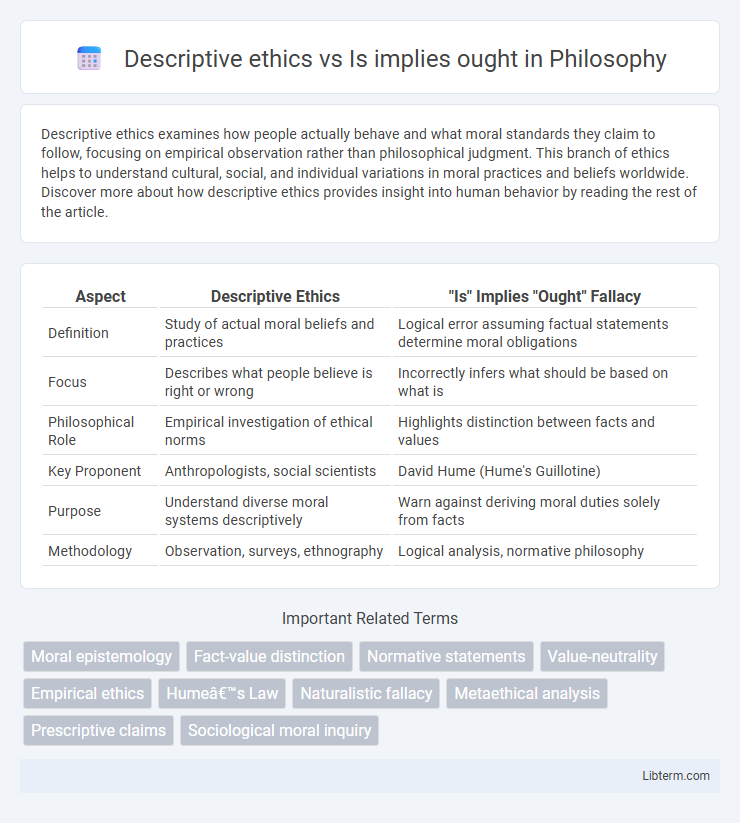Descriptive ethics examines how people actually behave and what moral standards they claim to follow, focusing on empirical observation rather than philosophical judgment. This branch of ethics helps to understand cultural, social, and individual variations in moral practices and beliefs worldwide. Discover more about how descriptive ethics provides insight into human behavior by reading the rest of the article.
Table of Comparison
| Aspect | Descriptive Ethics | "Is" Implies "Ought" Fallacy |
|---|---|---|
| Definition | Study of actual moral beliefs and practices | Logical error assuming factual statements determine moral obligations |
| Focus | Describes what people believe is right or wrong | Incorrectly infers what should be based on what is |
| Philosophical Role | Empirical investigation of ethical norms | Highlights distinction between facts and values |
| Key Proponent | Anthropologists, social scientists | David Hume (Hume's Guillotine) |
| Purpose | Understand diverse moral systems descriptively | Warn against deriving moral duties solely from facts |
| Methodology | Observation, surveys, ethnography | Logical analysis, normative philosophy |
Introduction to Descriptive Ethics
Descriptive ethics examines how people actually behave and what moral beliefs they hold across different cultures and societies. It focuses on empirical observation and analysis of ethical practices without making judgments about what is right or wrong. This contrasts sharply with the "is implies ought" problem, which critiques the assumption that factual statements about what is can directly determine moral obligations.
Understanding the "Is-Ought" Problem
Descriptive ethics examines how people actually behave and what moral beliefs they hold, providing empirical data about ethical practices, whereas the "is-ought" problem highlights the logical gap between stating facts ("is") and prescribing what ought to be done. Understanding the "is-ought" problem emphasizes that factual statements about human behavior or social conditions cannot logically determine moral imperatives without additional normative premises. This distinction is critical in ethics to avoid conflating descriptive observations with prescriptive conclusions, ensuring moral philosophy maintains valid arguments beyond empirical evidence.
Historical Background of Descriptive Ethics
Descriptive ethics, rooted in empirical research, examines actual moral beliefs and practices across cultures and historical periods without prescribing what ought to be done. Its historical background traces back to early anthropological studies in the 19th century, where scholars like Edward Tylor systematically documented diverse moral codes. This contrasts sharply with the "is implies ought" fallacy, a philosophical critique introduced by David Hume in the 18th century, which cautions against deriving normative ethical conclusions solely from descriptive facts.
Origins of the Is-Ought Distinction
The origins of the is-ought distinction trace back to the 18th-century Scottish philosopher David Hume, who identified a gap between descriptive statements about what "is" and prescriptive statements about what "ought" to be. Descriptive ethics examines moral beliefs and behaviors as they exist empirically without making normative judgments, whereas the is-ought problem highlights the logical challenge of deriving ethical prescriptions solely from factual premises. Understanding this distinction is crucial for differentiating between observing human conduct and formulating moral obligations.
Key Differences: Descriptive Ethics vs Is-Ought Gap
Descriptive ethics examines how people actually behave and what moral beliefs they hold, using empirical observation and data collection to understand ethical practices across cultures. The is-ought gap, articulated by philosopher David Hume, highlights the logical problem that one cannot directly derive prescriptive moral statements ("ought") solely from descriptive facts ("is"). This key difference underlines that descriptive ethics focuses on what is, while the is-ought gap addresses the philosophical boundary preventing straightforward transitions from factual statements to normative ethical conclusions.
Major Philosophers on the Is-Ought Problem
David Hume is a key philosopher who articulated the Is-Ought Problem, emphasizing the logical gap between descriptive statements (what *is*) and prescriptive statements (what *ought* to be). G.E. Moore further developed this in his "naturalistic fallacy," arguing that moral properties cannot be derived solely from natural facts. Contemporary ethicists like Philippa Foot and Elizabeth Anscombe have expanded on these ideas, focusing on how ethical reasoning bridges facts and values without conflating descriptive ethics with normative ethics.
Applications of Descriptive Ethics in Modern Society
Descriptive ethics systematically examines actual moral beliefs and behaviors across cultures, providing valuable data for policymakers, businesses, and social scientists to understand societal norms and ethical diversity. This empirical approach aids in designing culturally sensitive laws, ethical guidelines, and organizational codes of conduct by reflecting real-world values rather than prescribing ideal norms. Unlike the is-ought problem, which highlights the logical gap between factual statements and moral prescriptions, descriptive ethics offers practical insights into existing moral frameworks that influence decision-making processes in modern society.
Critiques and Limitations of Descriptive Ethics
Descriptive ethics faces critiques for its inability to provide normative guidance, as it merely reports what people believe or do without establishing what ought to be done. The "is implies ought" fallacy highlights the limitation that factual observations about moral behavior cannot justify ethical prescriptions or obligations. This gap underscores the necessity of normative ethics to address questions of moral value and justification beyond empirical data.
Bridging the Gap: Can ‘Is’ Lead to ‘Ought’?
Descriptive ethics examines how people actually behave and what moral beliefs they hold, presenting factual accounts of ethical practices without judgment. The "is implies ought" problem, highlighted by philosopher David Hume, questions whether factual statements about what is can lead logically to prescriptive claims about what ought to be done. Bridging this gap requires identifying contextual values or principles within descriptive data that justify moral conclusions, suggesting that empirical insights combined with ethical frameworks can inform normative directives.
Conclusion: The Relevance of the Debate Today
Descriptive ethics provides empirical analysis of moral behaviors and practices, while the "is implies ought" debate critiques the logical leap from factual statements to normative conclusions. This distinction remains crucial today, especially in fields like bioethics, AI development, and environmental policy, where understanding descriptive realities informs but does not automatically dictate ethical norms. Acknowledging this difference ensures clearer moral reasoning and better-informed decision-making in complex societal issues.
Descriptive ethics Infographic

 libterm.com
libterm.com